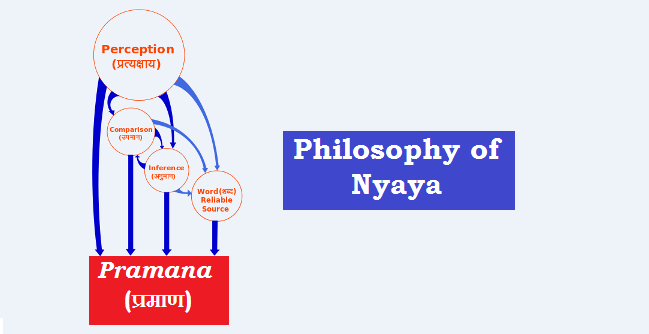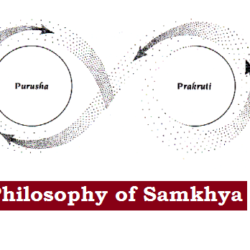
Nyaya means right thinking with proper arguments and valid reasoning. Therefore, it is also known as Tarkashastra (the science of reasoning). Nyaya School of thought is adhered to atomistic pluralism and logical realism. It is atomistic pluralism on the account that atom is the constituent of matter and there are not one but many entities, both material and spiritual, as ultimate constituents of the universe. It is a system of logical realism by adapting the doctrine that the world exists independently from our perceptions and knowledge. This school is founded by the sage Akspada Gautama.
Theory of knowledge: Prama and Aprama
According to Nyaya, knowledge reveals both the subject and the object which are quite distinct from itself. Knowledge may be valid or invalid. Valid knowledge is called Prama and, is defined as the right apprehension of an object. Non – Valid knowledge is known as Aprama.
The characterization of valid knowledge is a consequence of the correspondence theory of truth which states that truth is the correspondence between a proposition and reality. Thus, valid knowledge is treated as presentative knowledge. Presentative knowledge arises when the object of knowledge is directly present to the knower. Valid knowledge is produced by the four valid sources (Praman) of knowledge- perception, inference, comparison and testimony.
Invalid knowledge is defined as the wrong apprehension of object. It includes memory (Smruti), doubt (Samsaya), error (Viparyaya), and hypothetical reasoning (Tarka). Memory is not presentative but representative knowledge. Memory can also consider as a source of valid knowledge provided what is recalled or remembered were experienced in the past as a presentative cognition.
Four valid sources (Pramana) are:
- Perception (Pratyaksha):
- Perception is the direct and immediate cognition produced by the interaction between the object and five sense organs.
- For a perceptual cognition, four elements are necessary. These are; the self, mind, sense organs and objects.
- The self is in contact with the mind (Manas), the mind is in contact with the sense organs and lastly, the sense organs are in contact with the objects, as a result, we perceive objects.
- Inference (Anumana):
- The word ‘anu’ stands for ‘after’ and ‘mana’ means ‘cognition’. So it means ‘after cognition’. It is such knowledge which follows from other knowledge.
- An inference is constituted with at least three sentences named as major premise (Sadhya), minor premise (Paksa), and conclusion (Hetu) respectively.
- An example will clarify the above analysis: Major Premise: All things which have smoke have fire. Minor Premise: This hill has smoke. Conclusion: Therefore, this hill has fire
- In an inference, knowledge of an object is derived due to previous knowledge of some sign or mark. The previous knowledge is due to the universal relation between the major term and the middle term is being present in the minor term.
- Comparison (Upamana):
- The word ‘upa’ means similarity and the word ‘mana’ means ‘cognition’. So, it as a source of knowledge is derived from the similarity between two objects.
- Buddhist philosophy believes that comparison can be reduced to perception and testimony. The Samkhya and the Vaisesika Philosophy believe that comparison can be reduced to inference.
- Testimony (Sabda):
- ‘Sabda’ literally means verbal knowledge. It is the knowledge of objects derived from words or sentence.
- Sabda is the instructive assertion of a reliable person.
Compared to Nyaya School’s four Pramanas, Charvaka school has just one (perception), while Advaita Vedanta school recognizes six means to reliable knowledge.
Asatkaryavada: Theory of Causation
- Also known as ‘Arambhavada’, Nyaya Philoshy views that effect is produced by a cause but the effect and the cause are not one and the same.
- The effect is a new product comes to the existence which was not their earlier in the cause. Hence, every effect is a new product. For example, a pot is made by clay. Here ‘clay’ is the cause and ‘pot’ is its effect.
- This view of causation is directly opposed to the Samkhya- Yoga and Vedanta view of Satkaryavada, which explains the effect exists in its material cause prior to its production.

 Home
Home Syllabus
Syllabus Contact Us
Contact Us




